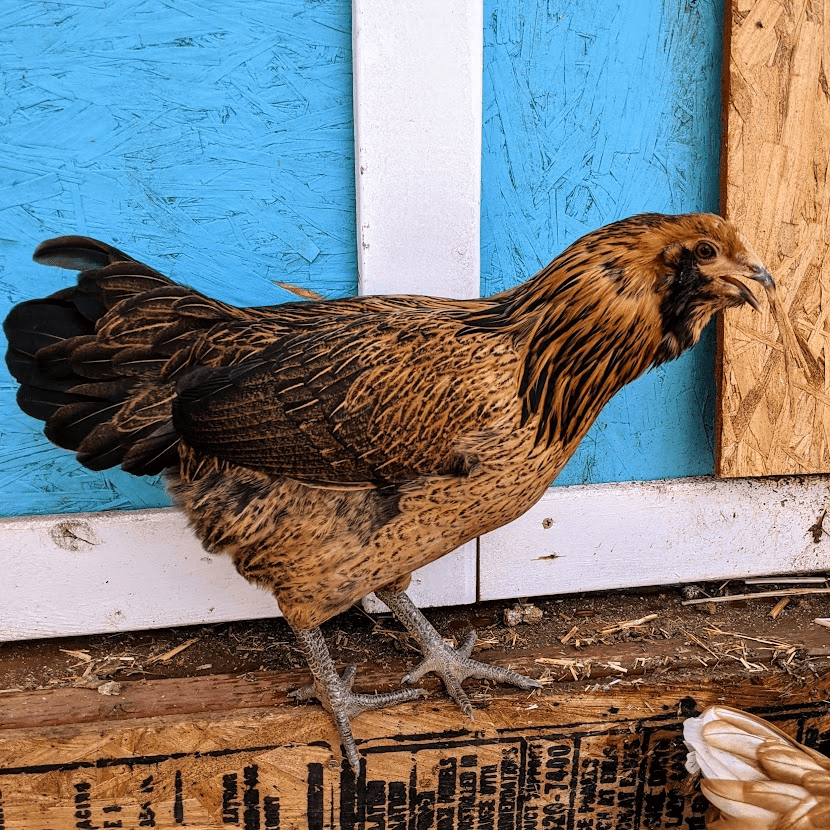Learn about the Easter egger chicken and if it’s a fit for your backyard. Perhaps one of the more difficult parts about keeping chickens is deciding which breed or breeds you’re going to keep. There are many chicken breeds to consider, but Easter egger chickens have quickly become one of the favorites in America.
Let’s take a closer look Easter eggers to help you decide whether this could be the right breed for you.
What Kind of Chickens Are Easter Eggers?
An Easter Egger can be classified as any chicken with the blue egg gene, but that doesn’t meet any particular breed standard. It lays beautifully-colored eggs, so it’s most commonly bred for egg-laying. However, they actually make a fantastic multi-purpose breed.
While their colorful eggs are great fun for kids, their low maintenance needs make them the perfect choice for busy or first-time chicken owners.
Breed Background
Easter Eggers are actually hybrid species created when people started crossbreeding Araucanas or Ameraucanas with other breeds. Araucanas originated in Chili and were brought to the USA in the 1930s, and are classed as “rumples” since they have no tail or coccyx.
They have small pea combs and ear tufts, the latter of which can be lethal to embryos if both parents have it, which makes them rare. They carry a dominant gene that produces blue eggs.
Ameraucanas were bred from Araucanas and mixed breed chickens to a breed standard. The ear tufts were bred out, while the dominant blue egg gene was kept.
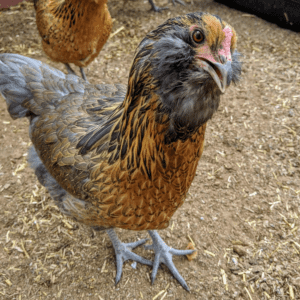
Easter Egger Hen Appearance
The appearance of a female Easter Egger can vary wildly since they aren’t bred to a specific standard. They’re more like the mongrels or mutts of the chicken world, so you never know what you’re going to get.
Depending on their specific parentage, they could have any sort of comb, although pea and single combs are the most common types. They can also vary widely when it comes to the color of their feathers and their facial features, sometimes featuring muffs, beards, or both.
Easter egger chickens usually have red or white earlobes and small red wattles. They also commonly weigh between four and five pounds when fully grown, with the hens being lighter than the roosters.
Due to having one Araucana parent like Prairie Bluebell Eggers do, the occasional bird will have ear tufts and, from time to time, maybe rumpless, but tailed birds are more common.
Easter Egger Temperament
Easter Eggers have gentle, sunny dispositions that mix well with other easy-going breeds, such as Cochins or Salmon Faverolles. They are friendly and curious and often approach humans for treats or just some attention and lap time. This is why they make such great pets and are always a top choice for families with young children.
Since they’re so gentle, they may get picked on by more aggressive breeds, so keep an eye on your flock to make sure they’re not getting bullied. Raise them with similar-mannered breeds such as Prairie Bluebell Eggers which lay blue eggs and Olive Egger chickens which lay olive-colored eggs.
Are Easter Eggers Good Layers?
Easter Egger hens are considered decent layers, but they don’t lay as many eggs as some other types, such as Golden Comets. Easter eggers typically lay an average of four large eggs per week, which means you can expect around 200 eggs throughout the course of a year.
They don’t get broody very often either, so you can rely on them to devote most of their time to egg-laying.
Especially broody breeds, such as the Silkie chicken, are not very reliable layers due to the sheer amount of time spent brooding instead of laying. The majority of people who keep this breed do so for their pretty, multi-colored eggs.
When fed and cared for properly, Easter Eggers will prove to be fairly frequent and reliable layers. Also, since Easter Eggers don’t lay quite as often as some other chickens, this means that they live longer.
In fact, the average lifespan of an Easter Egger chicken is eight years, although they have been known to live up to 10 years old. In terms of what age they start laying eggs, Easter Eggers usually begin a little later than other chickens. Usually, at around seven months old. That said, most people agree that their large and reliable supply of eggs is well worth the wait.
What Color Eggs Do Easter Egger Chickens Lay?
Since both species are known for laying blue eggs, crossbreeding them can result in various colored eggs. This is the reason their offspring were named Easter Egger chickens.
While most chickens lay white, tan, or brown eggs, Easter Egger eggs are different. An Easter Egger hen will only lay one color egg for her lifetime, but it could be a blue, green, or sometimes pink shade. Easter Eggers eggs are most often blue to green.
When a blue egg layer is crossed with a brown egg layer, for example, the resulting Easter Egger eggs can be a beautiful green or olive color. Owning a few Easter Egger hens can provide you with a nice array of multi-colored eggs each week.
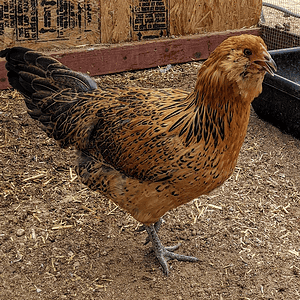
Why Choose Easter Eggers?
Since Easter Eggers aren’t an actual breed recognized by the American Poultry Association (APA), they aren’t raised for show purposes. However, they have a particularly devoted fan base that carries the motto “Thumbing our Noses at the APA Since 1976”.
You should choose Easter Eggers if you’re looking for happy, versatile birds. They will make an excellent choice for people looking for egg-layers, pets, or meat.
Productive Layers
Easter Eggers are kept for laying purposes. They are a great breed to own if you have a young family because of the fun colorful eggs they produce. Their eggs are also usually generous in size and tend to range from large to extra large.
They’re not the most abundant layers, but they are reliable, and an average of four eggs per week is still a decent amount of eggs. It’s important to note, the Ameraucana, is one of the best egg laying chickens, and Easter eggers are hybrids of this breed.
Pets
Easter Egger chickens also make superb pets because of their docile, personable, and friendly nature. They’re considered to be one of the friendliest types of chickens, along with Golden Buffs, Orpingtons, Rhode Island Red, and Silkies, among others.
It’s not uncommon for Easter Egger chickens to greet you at the gate or door and, if encouraged, will follow you around like a puppy. They really enjoy being petted and are ideal for teaching children about nature, agriculture, and caring for animals.
Meat
Weighing between four and five pounds, Easter Eggers are fairly decently-sized. This makes them worth keeping if you are looking to keep chickens for their meat. They may not be the first choice for solely meat production but are popular for their versatility in all areas. You can cull males and older hens who aren’t laying and use them for meat.
Adaptable
Easter Eggers are also considered one of the easiest chickens to raise since they are hardy and adaptable. Unlike some chicken breeds, Easter Eggers are both heat and cold tolerant. If you live in an area with very warm summers or particularly cold winters, it’s important to keep chickens that can cope with the climate.
Larger birds won’t tolerate warmer weather. Plus, these birds and their (usually) smaller cones make them less susceptible to frostbite.
Another factor that contributes to the Easter Eggers’ adaptability is that they also respond well to most living arrangements. Although they will enjoy free-ranging, they will also tolerate more confined living quarters, unlike breeds like the Sumatra chicken that won’t tolerate confinement well.
However, they have a curious and inquisitive nature, so if you’re raising them in a confined space, you should make sure they have a lot of stimulation.
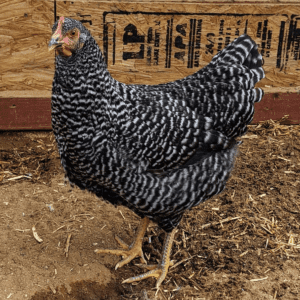
Low Maintenance
Easter Eggers are considered low maintenance birds, so they are a great choice for first-time bird owners. They’re usually very healthy birds that don’t have any major health issues you need to be aware of.
If your Easter Eggers have beards or muffs, then they can be more prone to parasites, but parasite problems should be expected with all breeds.
Some types of chickens, such as the Silkie chicken, need to have their feet cleaned and checked periodically, but you don’t usually have to worry about things like this with Easter Eggers.
They don’t have any specific dietary requirements, don’t get broody very often, and are also not aggressive and mix well with other friendly birds.
How to Keep Easter Eggers
If you want to breed Easter Eggers and since they’re not good brooders, you may have to resort to incubating the eggs yourself. But apart from that, keeping Easter Eggers is pretty easy because of their aforementioned low maintenance needs and adaptability.
The happier and healthier your chickens are, the better, so here are some tips for keeping them that way.
Chicken Coop
When considering how much space do chickens need, a rule of thumb for any chicken coop, not including outdoor space, is to allow at least 20 inches x 20 inches of space per chicken.
Make sure you have adequate space for nesting boxes, one box for every four or five birds. You must also have a roosting rail at least 1.5 inches wide for when the birds sleep.
Building or buying a coop that can be raised off the ground is a good idea. This will ensure they have a dry roosting space all year round.
Even if they are hardy birds, you should still ensure that they have a cozy coop in the colder months. Likewise, if you live in a hot climate, they will need access to shade.
Make sure their coop isn’t too drafty. Give them plenty of fresh, dry bedding such as wood shavings, straw, soft hay, ground corn cobs, or shredded paper. You could even consider introducing a heat lamp for the colder nights.
Chicken Run
It’s important to remember, Easter Eggers do enjoy foraging. They will enjoy following you around the garden. However, you can keep them in smaller, confined spaces if necessary. Easter Egger chickens can flap and get air born low to the ground, but they generally like to stick to the comfort of the flock. Unless you have another more flighty bird in your flock, the chances are that your Easter Eggers will stay put on your side of the fence.
Still, when building a chicken run for your Easter Eggers, don’t forget that they can fly. You should make sure to fully cover the run in chicken wire to prevent them from escaping. This will also help protect them from predators.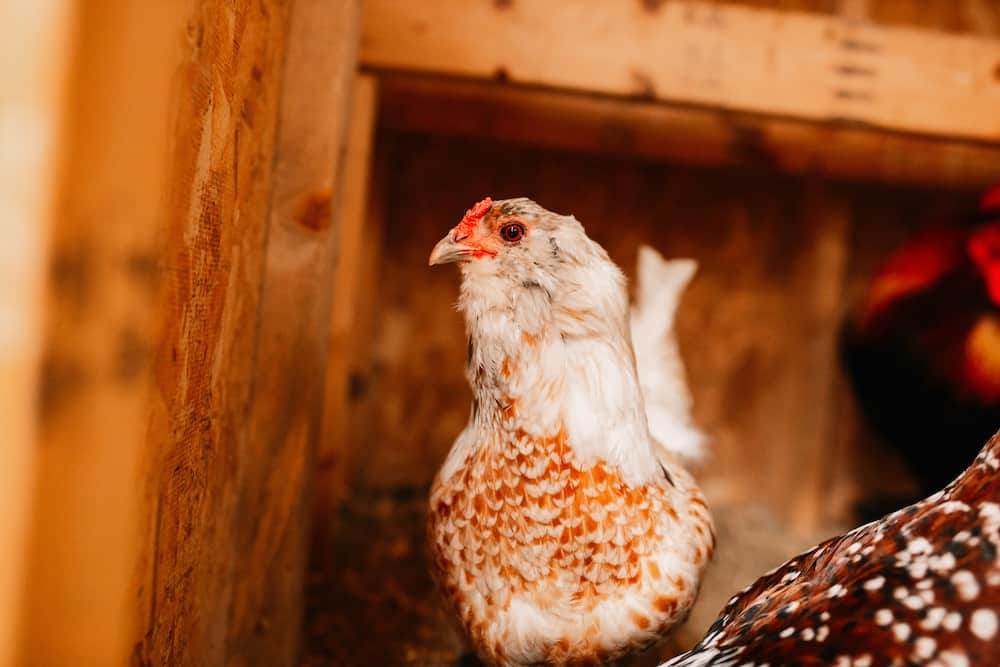
Easter Eggers Diet
What to feed Easter eggers is similar to any other chicken breeds and animals in general. You should always make sure your chickens have access to clean and adequate freshwater supply.
Also, if you’re like most people who plan on keeping Easter Eggers as layers, you should make sure you feed them with a special chicken layer feed.
Easter Eggers produce a fairly large amount of eggs. This means extra calcium and protein will be hugely beneficial to their diet.
Another ideas is to treating your flock of Easter Eggers with mealworm and live-culture yogurt several times a week. This will also help keep their plumage and health in prime condition.
Like most chickens, they love most fruits and vegetables. It’s okay to feed them your table scraps alongside an age-appropriate chicken feed. Just make sure you’re familiar with the kinds of food that you shouldn’t feed your chicken.
Lastly, chickens tend to eat more in the winter. This is because that’s when they expend the most energy. Therefore, be sure to increase their feed allowance over this time.
Easter Egger Chicks
Newborn chicks don’t need to eat for the first 72 hours of their life. This is because their bodies still absorb nutrients from inside the egg.
It’s important to know what to feed baby chickens after hatching. Be sure to feed your Easter Egger chicks a special chick starter feed. Start when they are three or four days old to around eight weeks old.
Flock Size
Easter Egger chicks and Easter egger chickens have a sociable nature. They tend to do better in a flock than on their own. A good practice is to keep a minimum of three chickens in your flock at any one time. However, you can keep more with enough space and resources.
Are Easter Eggers Right for You?
So, now you know more about Easter Egger Chickens, are they right for you? If you’re looking for a fun and happy addition to your egg-laying flock, then Easter Eggers will make a fantastic and versatile choice.
Salmon Faverolle – Why They’re Great to Raise

